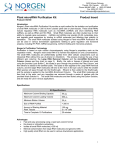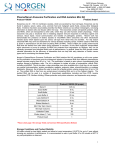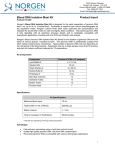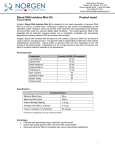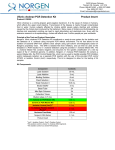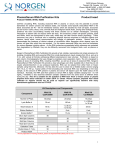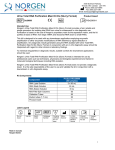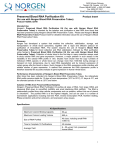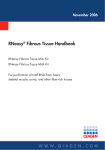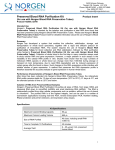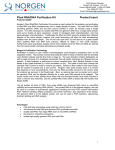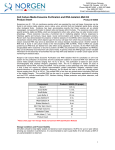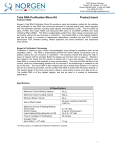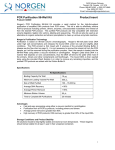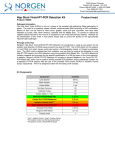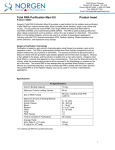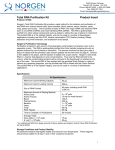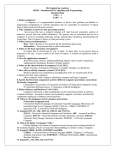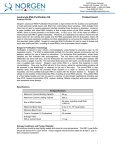Download Plant-Fungi Total RNA Purification Kit_Protocol 96
Transcript
3430 Schmon Parkway Thorold, ON, Canada L2V 4Y6 Phone: 866-667-4362 • (905) 227-8848 Fax: (905) 227-1061 Email: [email protected] Plant/Fungi Total RNA Purification 96-Well Kit Product Insert Product # 31900 Norgen’s Plant/Fungi Total RNA Purification 96-Well Kit provides a rapid method for the highthroughput isolation of total RNA from plants and fungi. The RNA is preferentially purified from other cellular components such as proteins, without the use of phenol or chloroform. The purified RNA is of the highest integrity, and can be used in a number of downstream applications including real-time PCR, Northern blotting, RNase protection, primer extension, and expression array assays. Norgen’s Purification Technology Purification is based on 96-well column chromatography using Norgen’s proprietary resin as the separation matrix. The RNA is preferentially purified from other cellular components such as proteins without the use of phenol or chloroform. The purification could be performed on either a vacuum manifold or using centrifugation. The process involves first homogenizing the cells or tissue with the desired disruption method. Lysis Solution is then added to the sample, and the lysate is then spun in a centrifuge in order to pellet and remove any debris (please see the flow chart on Page 4). Ethanol is then added to the clarified lysate, and the solution is loaded onto the 96-Well Filter Plate. Norgen’s resin binds RNA in a manner that depends on ionic concentrations. Thus only the RNA will bind to the resin in the wells, while the contaminating proteins will be removed in the flowthrough or retained on the top of the resin. The bound RNA is then washed with the provided Wash Solution in order to remove any remaining impurities, and the purified total RNA is eluted with the Elution Solution. The purified RNA is of the highest integrity, and can be used in a number of downstream applications. Specifications Kit Specifications Binding Capacity Per Well 50 µg Maximum Loading Volume Per Well 500 µL Size of RNA Purified All sizes, including small RNA (<200 nt) Maximum Amount of Starting Material: Fungi Plant Tissues 40 mg 40 mg Time to Complete 96 Purifications 30 minutes Average Yields* 25 mg of Grape leaves 40 mg Tomato Leaves 40 mg Tobacco Leaves 40 mg Peach Leaves 5-7 µg 20-30 µg 20-30 µg 15-20 µg * average yields will vary depending upon a number of factors including species, growth conditions used and developmental stage. Advantages • Fast and easy processing using either a vacuum manifold or centrifugation • No phenol or chloroform extractions • Isolate high quality total RNA from challenging plant samples 1 Kit Components Component Lysis Solution Wash Solution Elution Solution 96-Well Filter Plate Adhesive Tape 96-Well Collection Plate 96-Well Elution Plate Product Insert Product #31900 (192 preps) 2 x 40 mL 2 x 40 mL 20 mL 2 4 2 2 1 Storage Conditions and Product Stability All solutions should be kept tightly sealed and stored at room temperature. These reagents should remain stable for at least 1 year in their unopened containers. Precautions and Disclaimers This kit is designed for research purposes only. It is not intended for human or diagnostic use. Ensure that a suitable lab coat, disposable gloves and protective goggles are worn when working with chemicals. For more information, please consult the appropriate Material Safety Data Sheets (MSDSs). These are available as convenient PDF files online at www.norgenbiotek.com. Customer-Supplied Reagents and Equipment You must have the following in order to use the Plant/Fungi Total RNA Purification 96-Well Kit: • For Vacuum Format: o Vacuum manifold with vacuum pump capable of generating a minimum pressure of -650 mbar or -25 in. Hg (such as Whatman UniVac 3 Vacuum to Collect Manifold) o Sealing tape or pads • For Centrifuge Format: o Centrifuge with rotor for 96-well plate assembly (such as Thermo Fisher IEC Centra CL3 series or Beckman GS-15R) • • 96 - 100% ethanol Collection/Waste Tray for vacuum manifold or 96-well bottom plate (single or 96-well format) for centrifugation Cell Disruption Tool such as mortar and pestle, rotor-stator homogenizer or bead mills with liquid nitrogen β-mercaptoethanol (Optional) • • 2 Working with RNA RNases are very stable and robust enzymes that degrade RNA. Autoclaving solutions and glassware is not always sufficient to actively remove these enzymes. The first step when preparing to work with RNA is to create an RNase-free environment. The following precautions are recommended as your best defense against these enzymes. • The RNA area should be located away from microbiological work stations • Clean, disposable gloves should be worn at all times when handling reagents, samples, pipettes, disposable tubes, etc. It is recommended that gloves are changed frequently to avoid contamination • There should be designated solutions, tips, tubes, lab coats, pipettes, etc. for RNA only • All RNA solutions should be prepared using at least 0.05% DEPC-treated autoclaved water or molecular biology grade nuclease-free water • Clean all surfaces with commercially available RNase decontamination solutions • When working with purified RNA samples, ensure that they remain on ice during downstream applications 3 Flowchart Procedure for Purifying Total RNA using Norgen’s Plant/Fungi Total RNA Purification 96-Well Kit Lyse tissues or cells using desired disruption method Add Lysis Solution. Spin Add ethanol Bind RNA Wash three times with Wash Solution Elute RNA with Elution Solution Purified Total RNA 4 Procedures For Vacuum Manifold: All vacuum steps are performed at room temperature. The correct pressure can be calculated using the conversions: 1 mbar = 100 Pa = 0.0394 in. Hg = 0.75 mm Hg = 0.0145 psi For Centrifugation: All centrifugation steps are performed at room temperature. The correct rpm can be calculated using the formula: RPM = RCF (1.118 x 10-5) (r) where RCF = required gravitational acceleration (relative centrifugal force in units of g); r = radius of the rotor in cm; and RPM = the number of revolutions per minute required to achieve the necessary g-force. Notes Prior to Use • Ensure that all solutions are at room temperature prior to use. • Prepare a working concentration of the Wash Solution by adding 90 mL of 96%-100% ethanol (provided by the user) to each supplied bottle containing the concentrated Wash Solution. This will give a final volume of 130 mL. The label on the bottle has a box that may be checked to indicate that the ethanol has been added. • Optional: Add 10 µL of β-mercaptoethanol (provided by the user) to each 1 mL of Lysis Solution required. β-mercaptoethanol is toxic and should be dispensed in a fume hood. • The volumes stated in each procedure for lysate preparation are the volumes required to prepare samples for each well of the 96-well plate. 6 • The maximum recommended input of plant tissue is 40 mg or 5 x 10 plant cells per well of the 96-Well Filter Plate. In some cases it may be possible to increase the amount of 7 plant material processed up to 100 mg or 5 x 10 cells, depending on the RNA content of the plant. • Both fresh and frozen plant samples can be used for this protocol. Samples should be flash-frozen in liquid nitrogen and transferred immediately to a -70°C freezer for long-term storage. Do not allow frozen tissues to thaw prior to grinding with the mortar and pestle in order to ensure that the integrity of the RNA is not compromised. • It is important to work quickly during this procedure. • The purification of total RNA from the lysate prepared in Step1 could be performed using either a vacuum manifold or centrifugation. For purification using vacuum, please follow the procedure outlined in Section A. For purification using centrifugation, please follow the procedure outlined in Section B 1. Lysate Preparation a. Obtain a plant or fungi sample and determine the weight or cell number (see Notes Prior to Use regarding maximum recommended inputs). b. Transfer the sample to an appropriate vessel for the desired disruption method. c. Homogenize the tissues using the appropriate cell disruption tool. 6 d. Add 400 µL of Lysis Solution to each sample (For inputs up to 40 mg tissue or 5 x 10 plant cells). Proportionally increase the amount of Lysis Solution used depending on the sample input if processing a larger amount. Note: Ensure that frozen tissues do not thaw during weighing or prior to the addition of Lysis Solution. For maximum RNA recovery, homogenize frozen tissues to fine powder in liquid nitrogen prior to the addition of Lysis Solution. 5 e. Transfer all the lysate to RNase free 1.7 mL microtube (provided by the user) and centrifuge at 14,000 x g (~14,000 RPM) for 2 minutes. f. Using a pipette, transfer the clean lysate into a RNAase-free microcentrifuge tube (not provided). g. Add an equal volume of 96-100 % ethanol (provided by the user) to the lysate collected above (100 µL of ethanol is added to every 100 µL of lysate). Vortex to mix. Proceed to Step 2. Note: The purification of total RNA from the lysate prepared in Step 1 could be performed using either a vacuum manifold or centrifugation. For purification using vacuum, please follow the procedure outlined in Section A. For purification using centrifugation, please follow the procedure outlined in Section B A. Plant/Fungi Total RNA isolation Using Vacuum Manifold 2. Binding RNA to 96-Well Filter Plate a. Assemble the 96-Well Filter Plate and the vacuum manifold according to manufacturer’s recommendations. Apply up to 400 µL of the lysate mixed with the ethanol (from Step 1) into each well of the 96-Well Filter Plate. Note: The provided 96-Well Collection Plate can be used as the collection/waste tray if desired. b. Tape the plate or any unused wells using sealing tape or pads (provided by the user) according to the vacuum manifold manufacturer’s recommendations. Apply vacuum for 2 minutes. Note: Depending on the starting material, a small quantity of precipitates may appear in the lysate-ethanol mix. No additional step is required to remove these precipitates prior to application of the mixture to the wells. c. Turn off vacuum and ventilate the manifold. Discard the flowthrough. Reassemble the 96-Well Filter Plate and the vacuum manifold. Note: Ensure that all of the lysate from each well has passed through into the collection/waste tray. If the entire lysate volume has not passed, apply vacuum for an additional 2 minutes. d. Apply the remainder of the lysate mixed with the ethanol into each well and repeat steps 2b and 2c. Optional Step: Norgen’s Plant/Fungi Total RNA Purification 96-Well Kit isolates total RNA with minimal amounts of genomic DNA contamination. However, an optional On-Plate DNA Removal Protocol is provided in Appendix A for maximum removal of residual DNA that may affect sensitive downstream applications. This step should be performed at this point in the protocol. 3. RNA Wash a. Apply 400 µL of Wash Solution to each well of the 96-Well Filter Plate. Tape the plate or any unused wells using sealing tape or pads (provided by the user) according to the vacuum manifold manufacturer’s recommendations. Apply vacuum for 2 minutes. 6 Note: Ensure the entire wash solution has passed through into the collection/waste tray by inspecting the 96-Well Filter Plate. If the entire wash volume has not passed, apply vacuum for an additional 2 minutes. b. Turn off vacuum and ventilate the manifold. Discard the flowthrough. c. Reassemble the 96-Well Filter Plate and the vacuum manifold. Repeat steps 3a and 3b to wash column for a second time. d. Reassemble the 96-Well Filter Plate and the vacuum manifold. Repeat steps 3a and 3b to wash column for a third time. e. Pat the bottom of the 96-Well Filter Plate dry. Reassemble the 96-Well Filter Plate and the vacuum manifold. Apply vacuum for an additional 5 minutes in order to completely dry the plate. f. Turn off vacuum and ventilate the manifold. 4. RNA Elution a. Replace the collection/waste tray in the vacuum manifold with the provided 96-Well Elution Plate. Complete the vacuum manifold assembly with the 96-Well Filter Plate. b. Add 75 µL of Elution Solution to each well of the plate. c. Apply vacuum for 2 minutes. 5. Storage of RNA Use the provided adhesive tape to seal the Elution Plate. The purified RNA samples may be stored at –20°C for a few days. It is recommended that samples be placed at –70°C for long term storage. B. Plant/Fungi Total RNA Purification Using Centrifugation 2. Binding RNA to 96-Well Filter Plate a. Place the 96-Well Filter Plate on top of a provided 96-Well Collection Plate b. Apply up to 300 µL of the lysate mixed with the ethanol (from Step 1) into each well of the 96-Well Filter Plate. c. Centrifuge the assembly at maximum speed or 3,000 x g (~3,000 RPM) for 2 minutes. Note: Depending on the starting material, a small quantity of precipitates may appear in the lysate-ethanol mix. No additional step is required to remove these precipitates prior to application to the wells c. Discard the flowthrough. Reassemble the 96-Well Filter Plate and the 96-Well Collection Plate and repeat Step B2 b and c with remained lysate mixture. Note: Ensure that all of the lysate from each well has passed through into the bottom plate. If the entire lysate volume has not passed, centrifuge for an additional 2 minutes. 3. RNA Wash a. Apply 400 µL of Wash Solution to each well of the 96-Well Filter Plate. Centrifuge the assembly at maximum speed or 3,000 x g (~3,000 RPM) for 2 minutes. Note: Ensure the entire wash solution has passed through into the bottom plate by inspecting the 96-Well Filter Plate. If the entire wash volume has not passed, centrifuge for an additional 2 minutes. 7 b. Discard the flowthrough. Reassemble the 96-Well Filter Plate and the 96-Well Collection Plate. c. Repeat steps 3a and 3b to wash column for a second time. d. Repeat steps 3a and 3b to wash column for a third time. e. Pat the bottom of the 96-Well Filter Plate dry. Reassemble the 96-Well Filter Plate and the 96-Well Collection Plate. Centrifuge the assembly at maximum speed or 3,000 x g (~3,000 RPM) for 5 minutes in order to completely dry the plate. 4. RNA Elution a. Stack the 96-Well Filter Plate on top of the 96-Well Elution Plate. b. Add 75 µL of Elution Solution to each well of the 96-Well Filter Plate. c. Centrifuge the assembly at maximum speed or 3,000 x g (~3,000 RPM) for 2 minutes. 5. Storage of RNA Use the provided adhesive tape to seal the Elution Plate. The purified RNA sample may be stored at –20°C for a few days. It is recommended that samples be placed at –70°C for long term storage. Appendix A Protocol for Optional On-Column DNA Removal Norgen’s Plant/Fungi Total RNA Purification 96-Well Kit isolates total RNA with minimal amounts of genomic DNA contamination. However, an optional protocol is provided below for maximum removal of residual DNA that may affect sensitive downstream applications. It is recommended that an RNase-free DNase I be used. 1. Prepare a working stock of 0.25 Kunitz unit/µL RNase-free DNase I solution according to the manufacturer’s instructions. A 75 µL aliquot is required for each well to be treated. Alternatively, dissolve or dilute stock DNase I in a reaction buffer (40 mM Tris pH 8.0, 10 mM MgCl2 and 3 mM CaCl2, made RNase-free) to give a final concentration of 0.25 Kunitz unit/µL. 2. Perform the procedure up to and including “Binding RNA to 96-Well Filter Plate” (Steps 1 and 2 of all protocols) 3. For Vacuum Manifold: Apply 400 µL of Wash Solution to each well of the 96-Well Filter Plate. Tape the plate or any unused wells using sealing tape or a pad (provided by the user) according to the vacuum manifold manufacturer’s recommendations. Apply vacuum for 2 minutes. For Centrifugation: Apply 400 µL of Wash Solution to each well of the 96-Well Filter Plate. Centrifuge the assembly at maximum speed or 3,000 x g (~3,000 RPM) for 2 minutes. 4. Discard the flowthrough. Reassemble the 96-Well Filter Plate with the vacuum manifold or the bottom plate. 5. Apply 75 µL of the RNase-free DNase I solution prepared in Step 1 to each well of the 96Well Filter Plate. For Vacuum Manifold: Apply vacuum for 30 seconds. For Centrifugation: Centrifuge the assembly at maximum speed or 3,000 x g (~3,000 RPM) for 30 seconds. o 6. Incubate the assembly at 25 - 30 C for 15 minutes 7. Without any further centrifugation, proceed directly to “RNA Wash” Section 2A, Step 3b for Vacuum Manifold procedure or Section 2B, Step 3c for Centrifugation procedure. 8 Troubleshooting Guide Problem Poor RNA Recovery Clogged Wells in Plate Clogged Wells in Plate Possible Cause Solution and Explanation Incomplete lysis of cells or tissue Ensure that the appropriate amount of Lysis Solution was used for the amount of cells or tissue. Wells of the plate have become clogged Do not exceed the recommended amounts of starting materials. The amount of starting material may need to be decreased if the wells of the plate show clogging below the recommended levels. See also “Clogged Wells in Plate” below. An alternative elution solution was used It is recommended that the Elution Solution supplied with this kit be used for maximum RNA recovery. Ethanol was not added to the lysate Ensure that the appropriate amount of ethanol is added to the lysate before binding to the wells of the plate. Ethanol was not added to the Wash Solution Ensure that 90 mL of 96-100% ethanol is added to the supplied Wash Solution prior to use. Low RNA content in cells or tissues used Different tissues and cells have different RNA contents, and thus the expected yield of RNA will vary greatly from these different sources. Please check literature to determine the expected RNA content of your starting material. Insufficient solubilization of cells or tissues Ensure that the appropriate amount of lysis buffer was used for the amount of cells or tissue. Maximum number of cells or amount of tissue exceeds kit specifications Refer to specifications to determine if amount of starting material falls within kit specifications Insufficient Vacuum Ensure that a vacuum pressure of at least -650 mbar or 25 in. Hg is developed Centrifuge temperature too low Ensure that the centrifuge remains at room temperature throughout the procedure. Temperatures below 15°C may cause precipitates to form that can cause the wells to clog. 9 Problem RNA is Degraded RNA does not perform well in downstream applications Genomic DNA contamination Possible Cause Solution and Explanation RNase contamination RNases may be introduced during the use of the kit. Ensure proper procedures are followed when working with RNA. Please refer to “Working with RNA” at the beginning of this user guide. Procedure not performed quickly enough In order to maintain the integrity of the RNA, it is important that the procedure be performed quickly. Improper storage of the purified RNA For short term storage RNA samples may be stored at –20°C for a few days. It is recommended that samples be stored at –70°C for longer term storage. Frozen tissues or cell pellets were allowed to thaw prior to RNA isolation Do not allow frozen tissues to thaw prior to isolation in order to ensure that the integrity of the RNA is not compromised. Starting material may have a high RNase content For starting materials with high RNAase content, it is recommended that β-mercaptoethanol be added to the Lysis Solution. RNA was not washed 3 times with the provided Wash Solution Traces of salt from the binding step may remain in the sample if the plate is not washed 3 times with Wash Solution. Salt may interfere with downstream applications, and thus must be washed from the column. Ethanol carryover Ensure that the dry vacuum or dry spin under the RNA Wash procedure is performed, in order to remove traces of ethanol prior to elution. Ethanol is known to interfere with many downstream applications. Large amounts of starting material used Perform RNAse-free DNase I digestion on the RNA sample after elution to remove genomic DNA contamination. 10 Related Products Plant/Fungi Total RNA Purification Kit (50 preps) Plant/Fungi Total RNA Purification Kit (96 preps) Total RNA Purification Kit RNA/Protein Purification Kit RNA/DNA/Protein Purification Kit Cytoplasmic & Nuclear RNA Purification Kit microRNA Purification Kit 100b RNA Ladder 1kb RNA Ladder Product # 25800 31300 17200 23000 23500 21000 21300 15002 15003 Technical Support Contact our Technical Support Team between the hours of 8:30 and 5:30 (Eastern Standard Time) at (905) 227-8848 or Toll Free at 1-866-667-4362. Technical support can also be obtained from our website (www.norgenbiotek.com) or through email at [email protected]. 3430 Schmon Parkway, Thorold, ON Canada L2V 4Y6 Phone: (905) 227-8848 Fax: (905) 227-1061 Toll Free in North America: 1-866-667-4362 © 2012 Norgen Biotek Corp. PI31900-6 11











